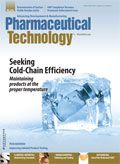End of the Dedicated CMO?
Is the contract-only CMO an endangered species?
Several formerly contract-only CMOs have converted, after recent acquisitions, to a more mixed model that combines contract manufacturing with proprietary products. The most prominent examples include Patheon's late 2012 acquisition of Banner Pharmacaps, a softgel manufacturer with its own lines of over-the-counter (OTC) and nutritional softgel products.

Jim Miller
The trend was further highlighted in 2012 with the acquisition of Metrics by Mayne Pharma, an Australian generic pharmaceutical company. Metrics has been known primarily for its analytical, formulation, and clinical manufacturing services, but the acquisition revealed that more than half of its $52 million in revenues came from sales of proprietary products it had developed internally. Conversations with other CDMOs indicate that a number of CDMOs have quietly pursued similar strategies in recent years.
The effort to build a proprietary revenue stream is not limited to dose CMOs. Contract manufacturers of APIs have also been pursuing these opportunities. For instance, the development of proprietary generic APIs has been a major initiative for DSM Pharmaceutical Products in the business strategy it rolled out in 2012; up to that point the company had focused primarily on custom manufacturing.
Companies that manufacture both their own products and client products have long been part of the CMO landscape. Most manufacturers of generic APIs have long offered custom manufacturing of advanced intermediates and proprietary APIs.
Many bio/pharmaceutical companies have been offering contract manufacturing as a means of boosting manufacturing-capacity utilization. Although most companies are satisfied to pick up the odd product, some share manufacturing capacity between proprietary products and a strategically important contract manufacturing business that has a substantial sales and project management infrastructure. This shared capacity model is especially common in the injectables segment of the CMO market.
There are other variants of the mixed proprietary–plus–contract model as well. Private-label manufacturers develop and manufacture products under their own application but package the product under the name of a contract client, usually a retailer. In a variation of that model, a generics drug company will out-license its products to other pharmaceutical companies and supply the manufactured product. A further variation of the model is a drug-delivery company that develops a product for a client using its proprietary drug-delivery technologies or know-how, and then manufactures the product for commercial supply.
Clear rationale
For CMOs entering the proprietary products game for the first time, the rationale seems rather clear:
- Better margins. Proprietary products typically promise better profitability than contract manufacturing. CMOs can capture the higher unit price of the finished product and the 40+% gross margin that drug companies can command.
- Better utilization. Proprietary products can absorb some of the unutilized capacity in CMO facilities. This utilization is especially valuable for solid-dose CMOs, among which there is significant excess capacity.
- Greater control and predictability. In the contract-only CMO model, manufacturers are totally at the mercy of their clients' marketing prowess and product success. With proprietary products, CDMOs can gain some predictability over revenues and utilization.
A move into proprietary products can be particularly attractive to smaller CDMOs that cannot gain traction in the contract manufacturing business and need an extra boost to drive growth. Global bio/pharma vendor-consolidation strategies favor larger CMOs with broader capabilities, which could leave smaller CMOs out of the mix and searching for new growth avenues.
Low entry barriers
CDMOs have real advantages for developing or acquiring proprietary products, because of their development and manufacturing infrastructure and know-how. The frequency and apparent ease with which they can enter the products business, however, highlights one of the great contradictions of the bio/pharmaceutical industry. While much attention is placed on the high cost of R&D and the high probability of failure, the industry has remarkably low barriers to entry. Cheap generic APIs, low-regulatory barriers for OTC products and products with previously approved APIs (505(b) 2 products), and the ability to scale manufacturing operations to niche markets enable all sorts of companies to be successful with proprietary products.
Efforts to clamp down on healthcare costs, however, could hamper that model going forward. In Europe and the US, governments and insurers are making it more difficult for new products to gain access to approved formularies and more difficult for physicians to prescribe off-formulary drugs. Market power is moving to larger generic-drug companies and to distributors that can offer a broad product list at competitive prices. That market power could make it harder for smaller products companies to break into the market.
PharmSource expects that a lot of CMO proprietary product-development efforts will be channeled to the OTC and nutritional segments of the market, especially private label. OTC and nutritional products are benefiting from growing consumer acceptance and are not subject to insurance limitations. Further, marketing of private label products is in the hands of the labeler rather than the bio/pharmaceutical company, which means that CMOs won't have to build sophisticated sales and marketing infrastructure. Finally, the know-how of CMOs to develop and manufacture products with differentiating features and benefits will be a plus in dealing with the retailers.
The CMO model was meant to be relatively low-risk because it avoided the inherent riskiness of new drug development while offering bio/pharmaceutical companies the benefits of lower manufacturing costs and no investment in manufacturing capacity. The model hasn't worked out that way, partly because of the low entry barriers to contract manufacturing, and partly because global bio/pharmaceutical companies have been able to greatly improve their internal manufacturing performance. As a result, the industry will increasingly see CMOs mimic the business model they were meant to replace.
Jim Miller is president of PharmSource Information Services, Inc., and publisher of Bio/Pharmaceutical Outsourcing Report, tel. 703.383.4903, Twitter@JimPharmSource, info@pharmsource.com, www.pharmsource.com.

Pharmaceutical Tariffs Are Imminent: How Industry is Bracing for Impact
April 16th 2025On April 14, 2025, the Trump Administration launched a national security-driven investigation into pharmaceuticals, a move that will likely result in tariffs being placed on pharmaceutical drugs, ingredients, and other components that are imported from outside of the United States.